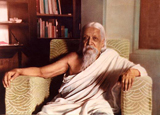Notes on counseling
A soul’s journey through illness
Introduction
Psychotherapy is about awareness and change. Normally, the psychotherapist uses the moment of crisis as a means to lead the patient to a greater awareness of himself. This greater awareness is expected to bring with it a greater power to change oneself. The awareness is reached by exploring the client’s past and discovering points of trauma which serve as a nucleus, around which develops the neurotic armour and the hidden complexes. All this, though useful in its own way, leaves two important questions unanswered. How far does the past extend? Is it confined to a simple life-time or does it extend through a series of many lives? Similarly, is this change an adjustment of sorts with our imperfect present or does it extend beyond our present life ? If we accept the continuity of life beyond death and before birth then indeed our present moment of crisis is like a shoot that has roots deep down that will bear fruits in the future. This gives new meaning and scope to the psychotherapeutic process.
The evolutionary journey
From the spiritual point of view, circumstances are not causes but results of our inner state. The cause of difficulty is inside us which attracts problems from outside. The external factor does not matter except as an occasion. The inner being transcends barriers of time and space, while limiting itself within these boundaries. This inner being that grows from life to life and birth to birth is the psychic being or soul. Our personality is a formation thrown out by the soul for a certain type of experience. The type of experience needed is determined by the level of consciousness at which the psychic being is. The soul, at each level, gathers certain elements of nature around it and relates with the world through these until it is ready to climb the next rung. It is the need of the growing soul that determines our personality and outer circumstances. These two act upon each other to provide the experience necessary to gradually shed the teguments that encase the psychic being. This armour, the armour of our ego and ignorance is the source of our perceived suffering. Our pains are the birth-pangs of the soul waiting to be delivered from its shell of the ego. This armour is however useful as it forestalls too rapid an ascent which may be precipitous for the world purpose. It prevents the seed from being burnt and wasted by too early an exposure to the light. The casing of the seed interacts with the darkness of the earth and is nourished by the waste. It splits open and is delivered to the light when it is ready.
Psychological suffering intervenes at a certain stage of this inner development. In the early stages, when the casing is hard and we are closer to the animal nature, there is very little suffering. During this stage, we might produce suffering in others, but hardly experience it ourselves. In fact, the absence of suffering in us creates an insensitivity to the suffering of others. This is a stage of the swoon of tamas from which our human journey begins.
Next intervenes a passage of psychological suffering. This pain is like a plough that tills our sleeping soil. It awakens us to the call for growth and progress. Yet, in the early stage, we misread the call and mistranslate the urge. The result is suffering that comes to remind us that our joys, and our victories are still imperfect. It is a reminder of our limitations. This is the stage of desire.
Generally, we begin to grow out of this first thrill of desire. We learn to widen ourselves and begin to consciously sacrifice our ego for a greater collective good. This is the sāttwic stage of our development. This stage is accompanied with increased sensitivity to the joys and suffering of others.
But here too the journey does not end. We need to one day transcend Nature entirely and stand as its lord and master. It is then that our suffering is exhausted and we are liberated from pain. The shell of the ego and ignorance is finally broken and we are free. And so comes our release from psychological pain and we hit the springs of a causeless, luminous joy and the all-surpassing peace which we always carry within us. We exchange the false passport and personage of our ego for the true identity of the soul.
The conflict in nature
This is our journey and there are many inner and outer forces that help or hinder us, though all ultimately serve the great cosmic purpose. The internal forces are the psychological components of our thought, feeling and will that are more or less pliable to the touch of the soul. These parts help or hinder depending on whether they are coarse or subtle in their movements, whether they aspire upward towards true and beautiful things or gravitate downwards towards low and obscure movements. These are the strengths and weaknesses of our complex personality which a psychotherapist needs to consider before any counselling. The nature and type of advice will differ depending on each one’s unique make-up. We are not one piece. It is this multiplicity of our inner elements that is the cause of an evolutionary conflict and source of much difficulty.
The universal dimension of conflict
This internal conflict has a universal dimension too. Since, spiritually speaking, we extend everywhere, a secret oneness binds each to the all. There are universal forces that aid or hinder our growth. These are the forces that work behind outer circumstances. Those that hinder are mainly of three types. First, there are the forces of universal nature which pass as a wave of contagion. If we are open or susceptible or simply live in the company of beings open to these forces, we become contaminated. Desire, anger and fear are forces that pass from one person to another as a contagion. So long as we maintain contact with such a person and are open to his influence, we continue being contaminated.
Second, there are the adverse forces which are powers of illusion. They make small things appear big, like our difficulties for instance. Or they make us lose heart and hope, discourage and depress us with doubts about ourselves and our recovery. They throw the suggestion of illness upon us or press upon our weak spots till they yield. We can arm ourselves against these forces by strengthening our weak spots and closing the gates of our nature which readily respond to their knock. Certain psychological qualities like goodwill, cheerfulness, faith and enthusiasm help us reinforce the armour against them.
Finally, there are the hostile forces. These, when permitted, run riot through our system. They create confusion in our thoughts, chaos and disorder in our will, feelings and impulses. They mercilessly attack our faith and will, eating up centuries of work, leaving one cold and indifferent in the heart and confused. They often give birth to impulses that are directly hostile to the divine work or create a false and perverted religiosity. It is these forces that can totally drive out our beautiful and noble parts, seize the human body and destroy it through suicide. The only armour against them is the Divine name and a persistent and invincible faith in the Divine victory and Grace.
Strengthening the soul’s armour and releasing the soul’s powers. There are also forces that help. It is here that the psychotherapist can intervene as an instrument of change. If he can forget himself and open to the divine influence and forces from above, become a clear, luminous and selfless channel, then his personality can become like a transmitter for these helpful forces. The client, in contact with the therapist, can absorb these forces and benefit if he is receptive enough and puts his faith on the side of recovery. The therapist, for his part, by a process of inner identification with the patient, can intuit rather than analyse the forces moving in the client. The intuitive knowledge can be supplemented by specific questions seeking detailed information as well as analysis. All this requires considerable inner development on the part of the therapist. Needless to say, our conventional knowledge of psychiatry/psychology is scarcely of help, except by providing an outer scaffolding to give us a glimpse into the client’s nature.
Once all this is clear then the contact with the therapist begins to serve as a catalyst for inner change. Through words, silent influence and even example, he can reinforce the client’s faith, repair his battered will, fill him with luminous energies of thought, quieten his mind and heart, disentangle his emotions from the web of falsehood and gradually serve the divine purpose of leading him towards Truth, Light, Freedom, Harmony and Bliss. The process can be long and arduous and each case passes through its own complex web as each person is unique. Suffice to say, the therapist can make use of all methods for the evolutionary purpose. But he must be careful not to reduce it into a fixed formula for all.
Conclusion
So the psychotherapeutic process is a journey of growth for client and therapist alike through a new forest each time. The general contours are perhaps similar but no two forests are alike. The clients naturally leave the therapist behind as they pass on to the other side of the forest, into the wide open spaces of the soul. Most, by then, become aware of the intricacies of their own nature, the ways of handling it, the general direction and purpose of their lives. The therapist, however, must return once again to work upon another forest and become a bridge for others to pass through. It is this goodwill and compassion, a tireless patience armed with the soul’s peace and joy that are the hallmark of an ideal psychotherapist.
The quintessence of spiritual psychotherapy (if we may use the term) is contained in these luminous words of Sri Aurobindo:
“As individual egos we dwell in the Ignorance and judge everything by a broken, partial and personal standard of knowledge; we experience everything according to the capacity of a limited consciousness and force and are therefore unable to give a divine response or set the true value upon any part of cosmic experience. We experience limitation, weakness, incapacity, grief, pain, struggle and its contradictory emotions or the opposite of these things as opposites in an eternal duality and not in the eternity of an absolute good and happiness. We live by fragments of experience and judge by our fragmentary values each thing and the whole... By entering into the cosmic consciousness we participate in that all-vision and see everything in the values of the Infinite and the One... We cease to judge men and things by their outward appearances and are delivered from hostile and contradictory ideas and emotions; for it is the soul that we see, the Divine that we seek and find in every thing and creature, and the rest has only a secondary value to us in a scheme of relations which exist now for us only as self-expressions of the Divine and not as having any absolute value in themselves. So too no event can disturb us, since the distinction of happy and unhappy, beneficent and maleficent happenings loses its force, and all is seen in its divine value and its divine purpose. Thus we arrive at a perfect liberation and an infinite equality. It is this consummation of which the Upanishad speaks when it says ‘He in whom the self has become all existences, how shall he have delusion, whence shall he have grief who knows entirely and sees in all things oneness...’ Still there are gradations and degrees. In the first stage the soul is still subject to the reactions of the duality, still subject therefore to the lower Prakriti; it is depressed or hurt by the cosmic suffering, elated by the cosmic joy. We suffer the joys of others, suffer their griefs, and this oneness can be carried even into the body,... But there must be a oneness in the freedom of Sachchidananda as well as with the subjection of the lower being to the reactions of Prakriti. This is achieved when the soul is free and superior to the cosmic reactions which are then felt in the life, mind and body as an inferior movement; the soul understands, accepts, sympathises, but is not overpowered or affected,... This does not mean insensibility to the struggles and sufferings of others, but it does mean a spiritual supremacy and freedom which enables one to understand perfectly, put the right values on things and heal from above instead of struggling from below. It does not inhibit the divine compassion and helpfulness, but it does inhibit the human and animal sorrow and suffering” (1).
Reference
1. Sri Aurobindo. The Synthesis of Yoga. Pondicherry; Sri Aurobindo Ashram Trust, 1970, pp. 395-399
Dr. Alok Pandey, a psychiatrist has been working through this way in his practice for many years.
Share with us (Comments,contributions,opinions)
When reproducing this feature, please credit NAMAH,and give the byline. Please send us cuttings.





